English | Dutch |
|
| On the way to the Caspian Sea | |
Osh (Kyrgyzstan) to Turkestan (Kazakhstan), August 2015
|
|
| |
|
After our visit to Tajikistan we take a rest for a few days in Osh. This is actually the only real Silk Road city of Kyrgyzstan, but you won’t see a lot of this past anymore nowadays. Therefore, Osh is for many travellers not much more than a transit point. From here you can travel via two routes to Tajikistan, or you can use the Irkehstam Pass to enter China. But Osh is in our opinion absolutely worth a visit. The bazaar is one of the most colourful in the country and although the town is the second largest in Kyrgyzstan, it still has a village atmosphere. From Osh we travelled to Jalal-Abad. As well as Osh, Jalal-Abad is part of the Fergana Valley, which is located for the biggest part in neighbouring country Uzbekistan. Osh and Jalal-Abad belong nowadays to Kyrgyzstan, because Soviet leader Joseph Stalin decided to redefine the borders in the region in the twenties of the last century, to deliberately divide ethnic groups over various autonomous regions. In this way he wanted to limit their power. These autonomous regions became independent countries after the fall of the Soviet Union, with the result that ethnic groups are divided over different countries; with ethnic tensions as a result. Bukhara and Samarkand for example, are actually Tajik cities, but belong to Uzbekistan. And many Uzbeks on the other hand, now live in Kyrgyzstan because Osh and Jalal-Abad have become part of Kyrgyzstan. These tensions led in 2010 to ethnic riots in Osh that left 200 dead. |
|
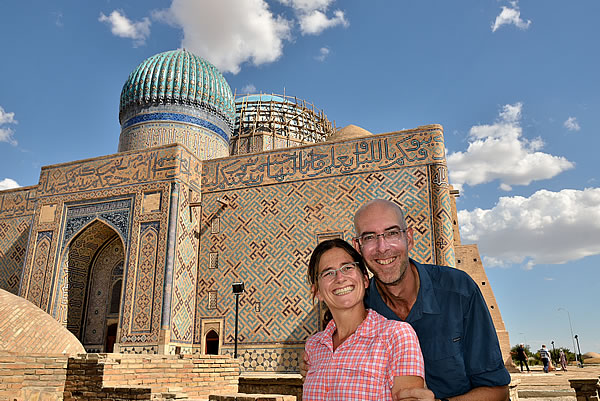 |
|
Us in front of the
of Ahmed Kozha Yasaui
Mausoleum in Turkestan |
|
From Jalal-Abad, we took the road through the mountains to Kazarman. This road is only open in the summer because snow makes the higher passes impassable until late in spring. The route is indeed beautiful and can be driven with a normal car. This to the contrary to what some guidebooks suggest; namely that the road is only passable by a four-wheel drive jeep. Leaving Kazarman was not easy, however. There is little traffic on the roads to and from this remote village. And that’s what the local taxi mafia also know. These guys do everything to knock as much money out of the pockets of travellers, often in collaboration with the owners of the homestays. But eventually we managed to get a ride, which took us via the Song-Kul Lake to Kochkor (see the column on the taxi mafia of Kazarman). The Song-Kul Lake is one of the most promoted destinations in Kyrgyzstan. The lake is located on a high plateau and the roads to the lake are spectacularly. But the lake itself is so big that you never really get a pretty view on it. Furthermore, in the high season, the place is so crowded that it is difficult to experience the serenity of the destination. However, we have heard stories from other travellers, and also seen their pictures, of visits earlier in the season. In June, the roads to the lake are only just opened and during that time, the tourist circus not yet in full swing. The mountains around the lake are still covered with snow giving the Song-Kul Lake area an almost magical atmosphere. This is undoubtedly a better time to visit the lake. The weekends in high season are better avoided. Once back in the capital Bishkek we went to the embassy of Azerbaijan to apply for a visa. We thought that it would be a difficult and expensive process, but it wasn’t that bad. We had to fill in a few forms, write a letter of intention to explain why we so badly want to go to Azerbaijan, and deposit 35 Euro per person on the bank account of the embassy. Then we had to wait for a week and we used that time to visit Almaty, the largest city in Kazakhstan. Kazakhstan can now be visited visa-free if your stay is shorter than 15 days. After our return from Almaty we picked up our visas and we immediately went to the Kazakh embassy to apply for the Kazakhstan visas. We are planning to travel through Kazakhstan to the Caspian Sea and onwards to Azerbaijan and for that route we need more than 15 days, which makes a Kazakh visa a necessity. While waiting for this visa, we decided to visit the Kyrgyz town Karakol. |
|
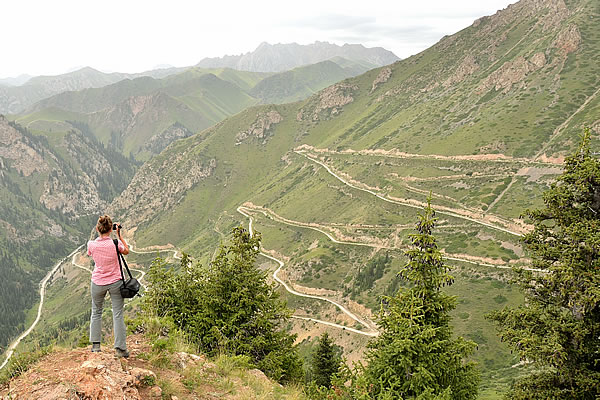 |
|
The spectacular road to the Song-Kol Lake from Ak-Tal |
|
| Karakol is the "hiking capital" of Kyrgyzstan. The route to Karakol runs from Bishkek for a large extent along the shores of the massive Issyk-Kol Lake. This lake is especially popular among the Kyrgyz and Kazakh tourists, for whom this lake is a great alternative to a sea, which in this part of the world is some light years away. However, there are also foreign tourists who are coming here. And we do not really understand why. We have to admit that we are not enthusiastic swimmers ourselves, but even with the best will in the world, we can’t really see the charm of this lake. The area around the lake is arid, yellow and dusty. The towns are bleak and the trees are felled to serve as firewood in the harsh winters. In addition, the lake is heavily polluted. That is not only because of all the scary things that happened here during the time of the Soviet Union, but also because of the chemicals that are still used in the nearby Kumtor gold mine, which eventually finds its way to the lake. The fish caught in this lake, has undoubtedly a very long shelf life. Back in Bishkek, we picked up our visas for Kazakhstan, and began our journey to the Caspian Sea. Many other travellers who do this long route (over 3000 km), take some night trains to quickly cover the long distances. We do not like to travel during the night and decide to travel from town to town. And since Kazakhstan has no really many major attractions in this region of the country, the smaller towns are often good places to experience the country in a proper way. And there aren’t many other travellers who do come here, so expect to be a rarity. We are now almost a week in Kazakhstan and we haven’t seen other tourists so far. After visits to the towns of Taraz and Shimkent, we arrived in Turkestan. The town itself is nothing special, but the mausoleum here, built in the late 14th century by Timur in honour of Ahmed Kozha Yasaui, is undoubtedly the most impressive building in present Kazakhstan. |
|
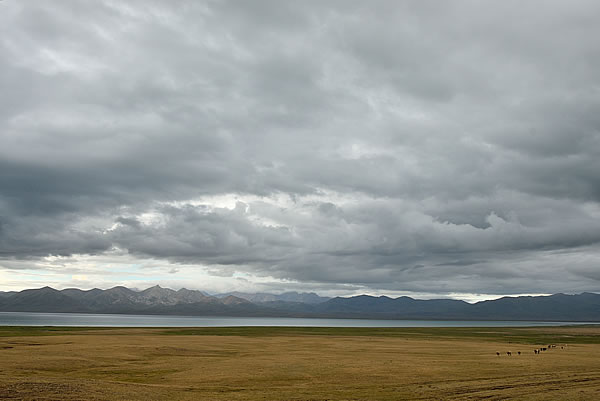 |
|
Dark clouds above Song-Kol Lake |
|
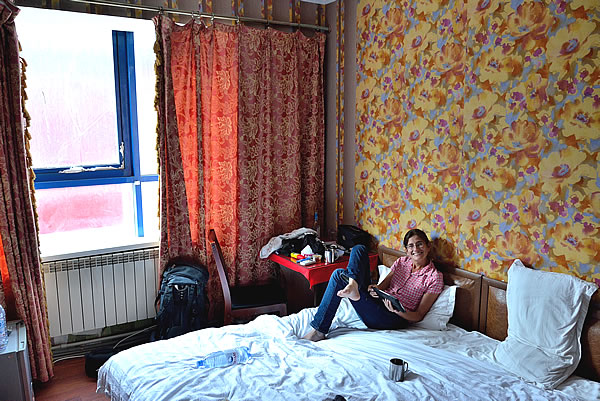 |
|
Ivonne skypes with her parents from our 'love hotel' room in Shimkent |
|
 |
|
Kazakh girls cool down in a fountain in Shimkent |
|
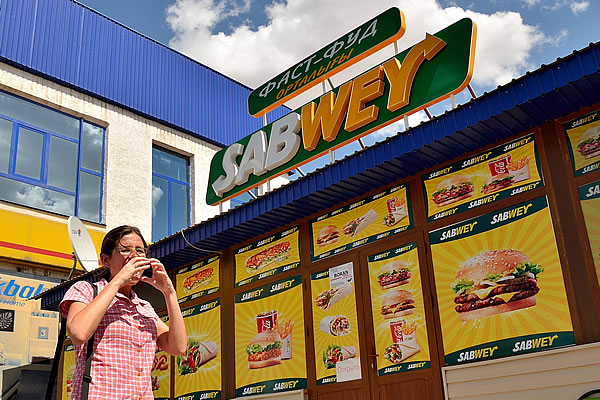 |
|
A good look-a-like SubWay restaurant in Turkestan |
|
 |
|
Hiking the the Karakol area (Kyrgyzstan) |
|
| <Previous weblog> | |